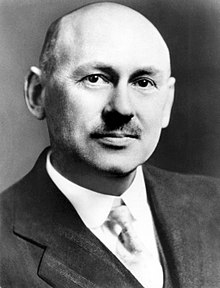Robert Goddard (scientist)
| Robert H. Goddard | |
|---|---|

Robert Hutchings Goddard (1882–1945)
Usherer of the Space Age |
|
| Born |
Robert Hutchings Goddard October 5, 1882 Worcester, Massachusetts, U.S. |
| Died | August 10, 1945 (aged 62) Baltimore, Maryland, U.S. |
| Cause of death | Throat cancer |
| Nationality | American |
| Education |
Worcester Polytechnic Institute Clark University |
| Occupation | Professor, aerospace engineering, physicist, inventor |
| Known for | First liquid-fueled rocket |
| Spouse(s) | Esther Christine Kisk (m. 1924–45) (1901–1982) |
| Children | No children |
| Parent(s) | Fannie Louise Hoyt Nahum Danford Goddard |
| Awards | Daniel Guggenheim Medal (1964) |
Robert Hutchings Goddard (October 5, 1882 – August 10, 1945) was an American engineer, professor, physicist, and inventor who is credited with creating and building the world's first liquid-fueled rocket Goddard successfully launched his model on March 16, 1926 ushering in an era of space flight and innovation. He and his team launched 34 rockets between 1926 and 1941, achieving altitudes as high as 2.6 km (1.6 mi) and speeds as fast as 885 km/h (550 mph).
Goddard's work as both theorist and engineer anticipated many of the developments that were to make spaceflight possible. He has been called the man who ushered in the Space Age. Two of Goddard's 214 patented inventions — a multi-stage rocket (1914), and a liquid-fuel rocket (1914) — were important milestones toward spaceflight. His 1919 monograph A Method of Reaching Extreme Altitudes is considered one of the classic texts of 20th-century rocket science. Goddard successfully applied three-axis control, gyroscopes and steerable thrust to rockets, to effectively control their flight.
Although his work in the field was revolutionary, Goddard received very little public support for his research and development work. The press sometimes ridiculed his theories of spaceflight. As a result, he became protective of his privacy and his work. Years after his death, at the dawn of the Space Age, he came to be recognized as one of the founding fathers of modern rocketry, along with Robert Esnault-Pelterie, Konstantin Tsiolkovsky and Hermann Oberth. He not only recognized the potential of rockets for atmospheric research, ballistic missiles and space travel but was the first to scientifically study, design and construct the rockets needed to implement those ideas.
...
Wikipedia
